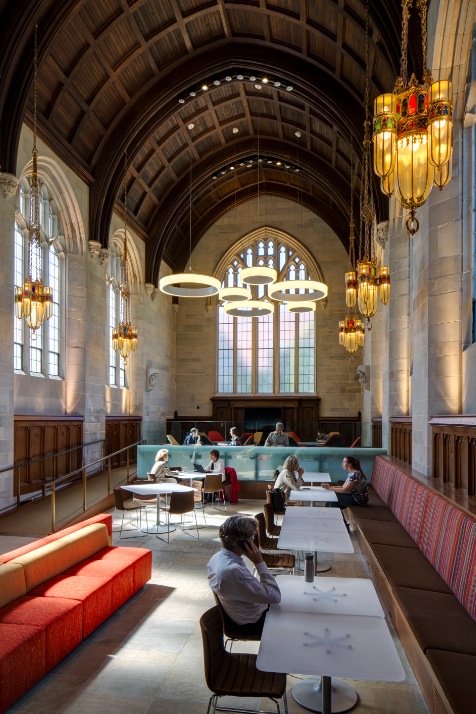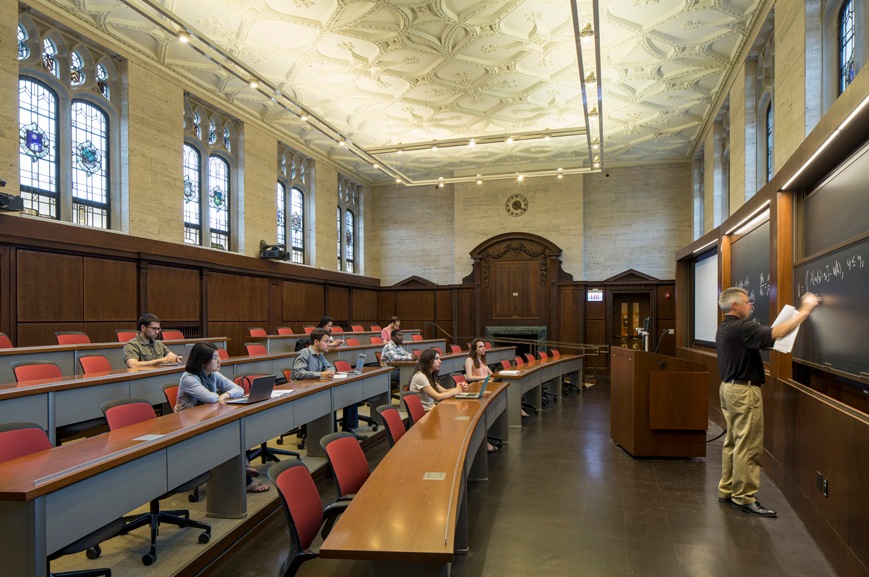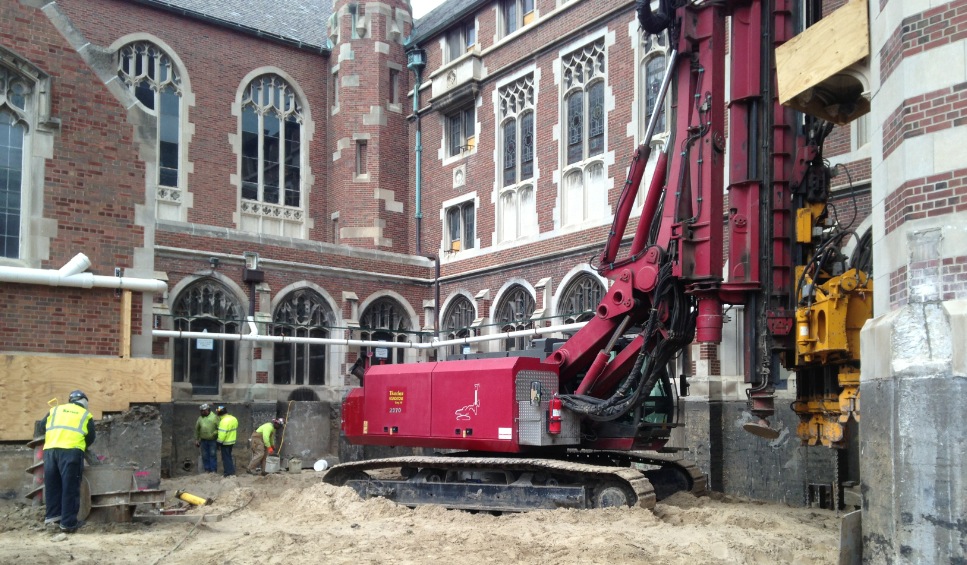In 2008, the University of Chicago announced plans to acquire the Chicago Theological Seminary, with the intention of using that building to expand the university’s world-renowned economics department.
At the time, the acquisition was controversial. Preservation Chicago was concerned enough about the nearly 90-year-old seminary losing its historical identity the advocacy group put the building on its annual “Most Threatened” list. Some faculty members weren’t thrilled about a research institute within the proposed complex being named (along with Nobel laureate Gary Becker) for Nobel Prize-winning economist Milton Friedman, a polarizing figure in academia.
PLATINUM AWARD
University of Chicago Saieh Hall for Economics | Chicago, Ill.
Building Team
Submitting firms: Turner Construction Company (CM) and Thornton Tomasetti (SE)
Owner: The University of Chicago
Architect: Ann Beha Architects
Architect of record: Gensler
MEP engineer: dbHMS
Landscape architect: OLIN
General Information
Size: 149,690 sf
Project cost: $110,100,000
Construction time: November 2012 to March 2015
Delivery method: CM at risk
Those objections were minor bumps in the road compared to what it took to convert the five-story, 100,000-sf seminary—with its two chapels, a bell tower, classrooms, and dormitories—into a modern education facility that would be fully integrated into the university’s Hyde Park campus. The east and west wings of the seminary, a red brick Gothic fortress enclosed by an eight-foot-high wall, were split by a city alley that cut through the center of the building. The seminary had inefficient steam heat and window air-conditioners. The building was too small to accommodate the university’s vision for the final product.
In the Building Team Awards judges’ estimation, the project demonstrated the university’s commitment to finding a balance between new construction and adaptive reuse of historically significant buildings. It is a textbook example of how innovative, collaborative design, engineering, and construction can overcome the physical limitations of a building to achieve the owner’s goals.
In essence, the university and its Building Team carved out usable space within the seminary’s existing footprint where there seemed to be none.
Ann Beha Associates called for removing the outside wall and closing off a street near the seminary; this became a pedestrian thoroughfare that extends the university’s main quadrangle by a block. The alley was also closed, and the entrance was retrofitted with a glass-sheathed lobby and second-floor conference room that unify the two wings. To the rear of the lobby, a steel, concrete, and glass stairwell draws natural light into the building.
The second big architectural decision was to excavate common areas in front of the wings below their foundations to create underground spaces for a 90-seat lecture hall on the east side and MEP equipment on the west. “It is practically an entire starship, hiding underground,” said Harald Uhlig, former chair of the university’s economics department, of the mechanical spaces. The attic, where such equipment would usually be positioned, was repurposed into a study loft with desks for 75 graduate students.
The building’s footings adjacent to the excavation had to be underpinned with jacked piles to prevent settlement and alleviate surcharge loading. The high-capacity jacked piles, capable of withstanding a force of 210 kip per pair, are believed to be the heaviest such underpinning ever permitted by the city of Chicago.
The Building Team had to develop and test the earth retention solutions, underpinning, and shoring for the deeper basement spaces months in advance of the start of construction. During construction, 80% of the existing basement walls in the east wing were temporarily supported, demolished, and resupported with new structural members. This was necessary in order to accommodate new HVAC, improved egress, and new room configurations.
The Building Team used 3D modeling to frame the post-tensioned, cast-in-place beams that support the underground lecture hall. The street-level courtyards above the underground areas were returned as ADA-compliant public spaces accented by gardens and planters.
 The Seminary’s Taylor Chapel was repurposed as common space for the 75 students in the university’s graduate economics program. Tom Rossiter/courtesy Ann Beha Architects
The Seminary’s Taylor Chapel was repurposed as common space for the 75 students in the university’s graduate economics program. Tom Rossiter/courtesy Ann Beha Architects
Throughout Saieh Hall for Economics (the building’s new name) are small rooms and breakout spaces for interactive group work, and quiet areas for more solitary thinking and reflection. Carefully hidden LED lighting brightens an old Gothic cloister in the west wing. Ceiling-level clerestory glazing lets in natural light.
“The interior works because the flow … induces a cooperation in a way that most other buildings I’ve visited have failed [to do],” John List, who chairs the economics department, said about the renovated structure.
All told, 23,000 sf were added to the building within its existing physical footprint. Another 38,000 sf were constructed to the north for the Saieh Hall for Economics.
AN IPD, WITHOUT THE CONTRACT
A charter detailing the project’s goals and the framework of team interaction was signed by all team members and posted at several locations on the job site. Monthly meetings and quarterly surveys held team members accountable.
The AEC firms also established a comprehensive protection plan early on to preserve the quality of the original craftsmanship of the seminary during demolition and reconstruction.
The Building Team used iPads and BIM 360 in the field to review RFIs, create sketches, and produce field reports. A laser-scanned, point-cloud survey of the existing buildings provided the basis for the Revit model used to coordinate all the work.
 Tom Rossiter/courtesy Ann Beha Architects
Tom Rossiter/courtesy Ann Beha Architects
Team members also found ways to minimize the sound and vibration impact of the construction on nearby buildings, which include museums, offices, and two operating nursery schools. One solution, the “Nothing Hits the Ground” initiative, mandated that material fabrications be performed at a working height of 30–39 inches off the floor.
A “Ladders Last” policy—which, as its name implies, recommends using lifts, platforms, and scaffolding rather than ladders—was enforced as a safety measure. Over the course of 480,000 work hours, the project’s lost-time incident rate was 1.24; its recordable incident rate was 2.48. There were no fall incidents.
In typical University of Chicago fashion, Nobel Prize–winning professors held discussions with the project’s trade workers about how research and teaching performed in the new complex would impact the world. (Twenty-eight economics laureates are associated in some way with the university.)
While the contract terms indicated typical design-bid-build project delivery—and the university hired the design and construction management teams for this project separately—the seminary conversion was actually completed more in an integrated project delivery manner, minus a formal three-party contract.
By all accounts, the client is pleased with its new Saieh Hall for Economics. “Having a world-class facility will ensure that Chicago remains the hub of academics and researchers in related fields in the 21st century,” said Larry Blouin, the University of Chicago’s Director of Construction Management Capital Project Delivery, Facilities Services.
As for the Chicago Theological Seminary, in January 2012 it moved into a new four-story, LEED-certified building (designed by Nagle Hartray Architecture) that borders the University of Chicago campus. The seminary and the university partnered on the construction of the 78,000-sf building as part of the original purchase agreement.
 To expand Saieh Hall, the Building Team decided to excavate common areas to create
To expand Saieh Hall, the Building Team decided to excavate common areas to create
underground spaces for the MEP system and new lecture halls. Constructing those new spaces required a considerable amount of preconstruction modeling and testing of fortifications. Courtesy Turner Construction Company.
Related Stories
Reconstruction Awards | Nov 12, 2018
Cincinnati Music Hall: Saving a cultural anchor
Cincinnati uses ‘skillful triage’ to bring its endangered Music Hall up to date.
Reconstruction Awards | Dec 1, 2017
Rescue mission: Historic movie palace is now the centerpiece of Baltimore’s burgeoning arts hub
In restoring the theater, the design team employed what it calls a “rescued ruin” preservation approach.
Reconstruction Awards | Dec 1, 2017
Gothic revival: The nation’s first residential college is meticulously restored
This project involved the renovation and restoration of the 57,000-sf hall, and the construction of a 4,200-sf addition.
Reconstruction Awards | Dec 1, 2017
Rockefeller remake: Iconic New York tower is modernized for its next life
To make way for new ground-floor retail and a more dramatic entrance and lobby, the team removed four columns at the ground floor.
Reconstruction Awards | Nov 30, 2017
BD+C's 2017 Reconstruction Award Winners
Provo City Center Temple, the Union Trust Building, and the General Motors Factory One are just a few of the projects recognized as 2017 Reconstruction Award winners.
Reconstruction Awards | Nov 29, 2017
College credit: Historic rehab saves 50% on energy costs
The project team conducted surveys of students, faculty, and staff to get their input.
Reconstruction Awards | Nov 29, 2017
Amazing grace: Renovation turns a church into elegant condos
The windows became The Sanctuary’s chief sales edge.
Reconstruction Awards | Nov 28, 2017
Broadway melody: Glass walls set just the right tone for a historic lobby in Lower Manhattan
The adaptation of the 45,000-sf neoclassical lobby at 195 Broadway created three retail spaces and a public walkway.
Reconstruction Awards | Nov 27, 2017
Higher education: The rebirth of a Washington, D.C., high school
The project team, led by architect Perkins Eastman, restored the original cupola.
Reconstruction Awards | Nov 27, 2017
Bank statement: A project team saves a historic bank, yielding 100% leaseup for the developer
The project team had to fix poor renovations made in the ’50s.

















